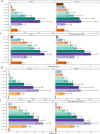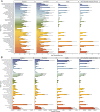Global, regional and national burden of infections among pregnant women, 1990-2021: a prospective cohort study
- PMID: 40480664
- PMCID: PMC12161437
- DOI: 10.1136/bmjopen-2024-096746
Global, regional and national burden of infections among pregnant women, 1990-2021: a prospective cohort study
Abstract
Objectives: We aimed to analyse the trends, age distribution and disease burden of maternal sepsis and other maternal infections (MSMI) to improve management strategies.
Design: We extracted data from the global burden of disease (GBD) 2021 database to evaluate MSMI burden with different measures for the whole world, 21 GBD regions and 204 countries from 1990 to 2021.
Setting: Studies from the GBD 2021 database generated by population-representative data sources identified through a literature review and research collaborations were included.
Participants: Patients with an MSMI diagnosis.
Outcomes: Total numbers, age-standardised rates (ASRs) of incidence, prevalence, mortality and disability-adjusted life years (DALYs) on MSMI from the GBD 2021 study and their estimated annual percentage changes (EAPCs) were the primary outcomes.
Results: There were 19 047 404 (95% uncertainty interval (UI) 14 608 563 to 24 086 486) annual incident cases, 2 376 876 (95% UI 1 678 868 to 3 421 377) prevalent cases at a single time point, 17 665 (95% UI 14 628 to 21 191) death cases and 1 144 233 (95% UI 956 988 to 1 352 034) DALYs of total MSMI in 2021. From 1990, the case number and ASRs of incidences and prevalence showed decreasing trends, while the case number and ASRs of mortality and DALYs gradually increased with time, reaching the peak in 2001, and then declined. In 2021, the ASRs of incidence, prevalence, mortality and DALYs sharply increased with age, which reached the peak in the 20-24 age group. The ASRs were decreased with increasing sociodemographic index (SDI). In 2021, it showed a positive correlation between EAPC and ASR of DALYs (r=0.3398, p<0.001).
Conclusions: The disease burden in low-SDI regions far exceeded that of regions with higher SDI. The persistent disparities in the burden of MSMI between low- and high-SDI regions underscore the urgent need for context-specific interventions, including targeted healthcare infrastructure investments in central and western sub-Saharan Africa, integration of WHO's Maternal Sepsis Guidelines into national policies, and prioritisation of antenatal care access for women aged 20-24 years. These strategies align with sustainable development goals to reduce maternal mortality and achieve universal health coverage by 2030.
Keywords: Maternal medicine; Mortality; Prevalence.
© Author(s) (or their employer(s)) 2025. Re-use permitted under CC BY-NC. No commercial re-use. See rights and permissions. Published by BMJ Group.
Conflict of interest statement
Competing interests: None declared.
Figures





Similar articles
-
Global, regional, and national burden of maternal disorders, 1990-2021: a systematic analysis from the global burden of disease study 2021.BMC Public Health. 2025 Jul 29;25(1):2576. doi: 10.1186/s12889-025-23814-w. BMC Public Health. 2025. PMID: 40730990 Free PMC article.
-
Global burden trends and future predictions of ischemic heart disease attributable to air pollution in people aged 60 years and older, 1990-2021.Front Public Health. 2025 Jul 4;13:1598092. doi: 10.3389/fpubh.2025.1598092. eCollection 2025. Front Public Health. 2025. PMID: 40687134 Free PMC article.
-
Global pattern, trend and cross-country inequalities of inguinal, femoral, and abdominal hernia among individuals aged 60 and above from 1990 to 2021 and projections until 2040: a population-based study.Surg Endosc. 2025 Jul;39(7):4335-4344. doi: 10.1007/s00464-025-11810-5. Epub 2025 May 28. Surg Endosc. 2025. PMID: 40437076
-
Burden of inflammatory bowel disease among elderly, 1990-2019: A systematic analysis based on the global burden of disease study 2019.Autoimmun Rev. 2025 Jan 31;24(2):103708. doi: 10.1016/j.autrev.2024.103708. Epub 2024 Nov 23. Autoimmun Rev. 2025. PMID: 39586389
-
Global burden and risk factors of childhood cardiovascular disease (1990-2021).Front Public Health. 2025 Jul 3;13:1543044. doi: 10.3389/fpubh.2025.1543044. eCollection 2025. Front Public Health. 2025. PMID: 40678645 Free PMC article. Review.
References
MeSH terms
LinkOut - more resources
Full Text Sources
Medical
